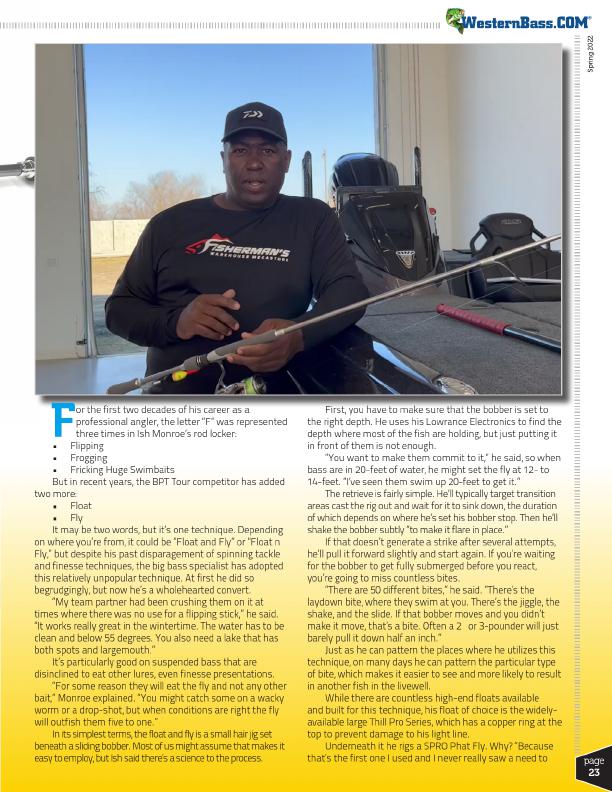
®
Spring 2022
F
or the first two decades of his career as a
professional angler, the letter “F” was represented
three times in Ish Monroe’s rod locker: • Flipping
• Frogging
• Fricking Huge Swimbaits
But in recent years, the BPT Tour competitor has added
two more:
• Float
• Fly
It may be two words, but it’s one technique. Depending
on where you’re from, it could be “Float and Fly” or “Float n
Fly,” but despite his past disparagement of spinning tackle
and finesse techniques, the big bass specialist has adopted
this relatively unpopular technique. At first he did so
begrudgingly, but now he’s a wholehearted convert.
“My team partner had been crushing them on it at
times where there was no use for a flipping stick,” he said.
“It works really great in the wintertime. The water has to be
clean and below 55 degrees. You also need a lake that has
both spots and largemouth.”
It’s particularly good on suspended bass that are
disinclined to eat other lures, even finesse presentations.
“For some reason they will eat the fly and not any other
bait,” Monroe explained. “You might catch some on a wacky
worm or a drop-shot, but when conditions are right the fly
will outfish them five to one.”
In its simplest terms, the float and fly is a small hair jig set
beneath a sliding bobber. Most of us might assume that makes it
easy to employ, but Ish said there’s a science to the process.
First, you have to make sure that the bobber is set to the right depth. He uses his Lowrance Electronics to find the depth where most of the fish are holding, but just putting it in front of them is not enough.
“You want to make them commit to it,” he said, so when bass are in 20-feet of water, he might set the fly at 12- to 14-feet. “I’ve seen them swim up 20-feet to get it.”
The retrieve is fairly simple. He’ll typically target transition areas cast the rig out and wait for it to sink down, the duration of which depends on where he’s set his bobber stop. Then he’ll shake the bobber subtly “to make it flare in place.”
If that doesn’t generate a strike after several attempts, he’ll pull it forward slightly and start again. If you’re waiting for the bobber to get fully submerged before you react, you’re going to miss countless bites.
“There are 50 different bites,” he said. “There’s the laydown bite, where they swim at you. There’s the jiggle, the shake, and the slide. If that bobber moves and you didn’t make it move, that’s a bite. Often a 2 ½ or 3-pounder will just barely pull it down half an inch.”
Just as he can pattern the places where he utilizes this technique, on many days he can pattern the particular type of bite, which makes it easier to see and more likely to result in another fish in the livewell.
While there are countless high-end floats available and built for this technique, his float of choice is the widely- available large Thill Pro Series, which has a copper ring at the top to prevent damage to his light line.
Underneath it he rigs a SPRO Phat Fly. Why? “Because that’s the first one I used and I never really saw a need to
page
23